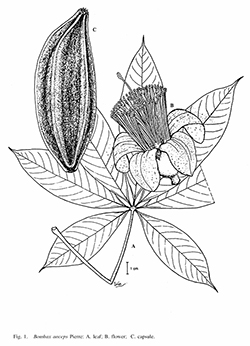e-Flora of Thailand
Volume 9 > Part 1 > Year 2005 > Page 11 > Bombaceae > Bombax
1. Bombax anceps Pierrewfo-0000568339
Fl. For. Cochinch.: t. 175. 1888; Gagnep. in Lecomte, Fl. Indo Chine 1: 450. 1910; Brandis, Ind. Trees; 78: 1906.— Gossampinus anceps (Pierre) Bakh., Bull. Jard. Bot. Buitenzorg S. 3. 6.: 190. 1924. Fig. 1; Plate III: D.
Accepted Name : This is currently accepted.
Synonyms & Citations :
Description : Large-sized tree, up to 30 m high; bark dark brown to blackish, covered with stout hard conical prickles, occasionally without; branches spreading, prickled; young twigs stout, with prominent leaf-scars. Leaves usually crowned at the end of twigs, with 5–7 unequal leaflets; the outer much smaller than the inner ones; leaflets obovate, elliptic, 8–18 by 4–8.5 cm; apex shortly acuminate; base slightly cuneate to acute; coriaceous, glabrous or glabrescent, pale on lower surface; secondary nerves in 10–15 pairs, arching and anastomosing near margin. Petioles 10–20 cm, glabrous or glabrescent, petiolules 1–1.5 cm. Flowers solitary, rarely 2–3 flowered, in the upper leaf-scars; buds ellipsoid, ca 3 by 1.5 cm; pedicel ca 1 cm, pubescent. Calyx campanulate, slightly, narrowed towards the base, ca 3–4 by 3 cm, with (3–)4(–5) unequal lobes, whitish hairy within. Petals white, occasionally greenish or pinkish; obovate, 7–9 by 1.5–2.5 cm, sparsely hairy inside, densely hairy outside, strongly reflexed in anthesis. Stamens numerous, densely tufted, 6–7 cm long, united at base to a disc-like staminal tube, enclosing ovary and lower part of styles then divided into 5 groups; anthers 1-celled, reniform, then twisted. Ovary ovoid, with 5-longitudinal ridges, pubscent; style cylindrical, glabrous, pinkish, 8–9 cm long, protruding from stamens; stigma dark pink with 5 cohering lobes. Capsule oblong, with 5 longitudinal ridges, usually curved to one side, woody, silky within, 10–18 by 4–7 cm, dehiscent. Seed numerous.
Thailand : NORTHERN: Chiang Mai, Nan, Phrae, Uttaradit, Tak, Kamphaeng Phet; SOUTH-WESTERN: Kanchanaburi, Prachaup Khiri Khan; CENTRAL: Saraburi; SOUTH EASTERN: Chanthaburi.
Distribution : Cambodia (type), Burma.
Ecology : In mixed deciduous and dry dipterocarp forests, often on limestone hill, 100–900 m alt. Flowering and fruiting: November–February.
Vernacular : Ngia pa dok khao (งิ้วป่าดอกขาว), ngiu dok khao (งิ้วดอกขาว), ngiu pha (งิ้วผา), krai (ไกร)(Northern); ngiu pa (งิ้วป่า)(Southwestern, Peninsular); nun pa (นุ่นป่า)(Central).
Uses: The cotton is used for stuffing mattresses and pillows. Wood is used for toys and indoor furniture.




